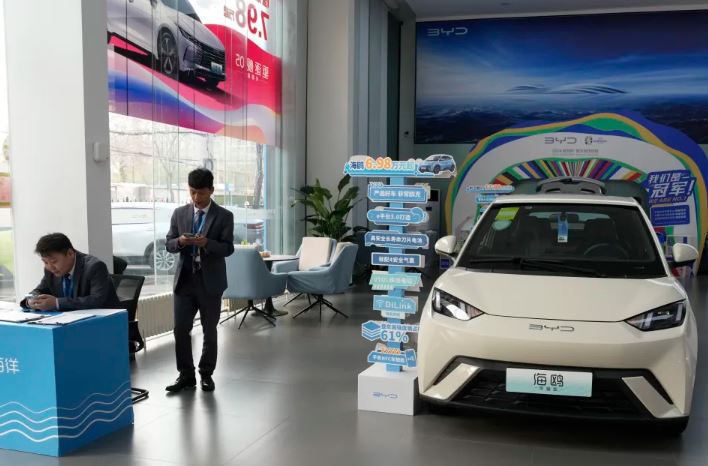Chinese EV Threat to U.S. Market
A tiny, low-priced electric car called the Seagull has American automakers and politicians trembling. The car, launched last year by Chinese automaker BYD, sells for around $12,000 in China, but drives well and is put together with craftsmanship that rivals U.S. electric vehicles that cost three times as much. A shorter-range version costs under $10,000. Tariffs on imported Chinese vehicles will keep the Seagull out of America for now, and it likely would sell for more than 12 grand if imported. But the rapid emergence of low-priced EVs from China could shake up the global auto industry in ways not seen since Japanese makers arrived during the oil crises of the 1970s. BYD, which stands for “Build Your Dreams,” could be a nightmare for the U.S. auto industry.
Challenges and Efficiencies in Manufacturing
There’s no single miracle that explains how BYD can manufacture the Seagull for so little. Instead, Woychowski said the entire car, which can go 252 miles (405 kilometers) per charge, is “an exercise in efficiency.” Higher U.S. labor costs are a part of the equation. BYD also can keep costs down because of its battery-making expertise — largely lithium iron phosphate chemistry used in consumer products. The batteries cost less but have lower range than most current lithium-ion batteries. Americans are still learning to make cheaper batteries, Woychowski said. BYD also makes many of its own parts, including electric motors, dashboards, and bodies, using its huge scale — 3 million vehicles sold worldwide last year — for cost savings. It designs vehicles with cost and efficiency in mind, he said. For instance, the Seagull has only one windshield wiper, eliminating one motor and one arm, saving on weight, cost and labor to install. U.S. automakers don’t often design vehicles this way and incur excess engineering costs, Woychowski said. The efficiency means weight savings that add up, allowing the Seagull to travel farther per charge on a smaller battery. So Detroit needs to quickly re-learn a lot of design and engineering to keep up while shedding practices from a century of building vehicles, Woychowski said.
Assessing U.S. Readiness and Response
Inside a huge garage near Detroit, a company called Caresoft Global tore apart a Seagull that its China office purchased and shipped to the U.S. Company President Terry Woychowski, a former chief engineer on General Motors’ pickup trucks, said the car is a “clarion call” for the U.S. industry, which is years behind China in designing low-cost EVs. After the teardown, Woychowski said he was left wondering if U.S. automakers can adjust. “Things will have to change in some radical ways in order to be able to compete,” he said. The Seagull still has a quality feel. Doors close solidly. The gray synthetic leather seats have stitching that matches the bright green body color, a feature usually found in more expensive cars. The Seagull tested by Caresoft has six air bags and electronic stability control. A brief drive through some connected parking lots by a reporter showed that it runs quietly and handles curves and bumps as well as more costly EVs. While acceleration isn’t head-snapping like other EVs, the Seagull is peppy and would have no problems entering a freeway.
Market Dynamics and Regulatory Challenges
BYD would have to modify its cars to meet U.S. safety standards, which are more stringent than in China. Woychowski says Caresoft hasn’t done crash tests, but he estimated that would add a couple thousand dollars to the cost. BYD sells the Seagull, also called the Dolphin Mini, in four Latin American countries for about $21,000. The higher price includes transportation and reflects higher profits possible in less cutthroat markets than China. BYD told The Associated Press last year it is “still in the process” of deciding whether to sell autos in the U.S. It is weighing factory sites in Mexico for the Mexican market. The company’s CEO said at a conference in May that it has no plans to sell EVs in the U.S. BYD EVs aren’t being sold in the U.S. now largely because of 27.5% tariffs on the sale price of Chinese vehicles when they arrive. Donald Trump slapped on the bulk of the tariff, 25%, when he was president, and it was kept in place under Joe Biden. Trump contends that the rise of EVs backed by Biden will cost U.S. factory jobs, sending the work to China. The Biden administration has backed legislation and policies to build a U.S. EV manufacturing base. Some members of Congress are urging Biden to ban imports of Chinese vehicles altogether, including those made in Mexico by Chinese companies that now would come in largely without tariffs.
Industry Response and Countermeasures
Ford CEO Jim Farley, has seen Caresoft’s work on the Seagull and BYD’s rapid growth, especially in Europe. He’s moving to change his company. A small “skunkworks” team is designing a new, small EV to keep costs down and quality high, he said earlier this year. Chinese makers, Farley said, sold almost no EVs in Europe two years ago, but now have 10% of the EV market. It’s likely they’ll export around the globe and possibly sell in the U.S. Ford is preparing to counter that. “Don’t take anything for granted,” Farley said. “This CEO doesn’t.”

